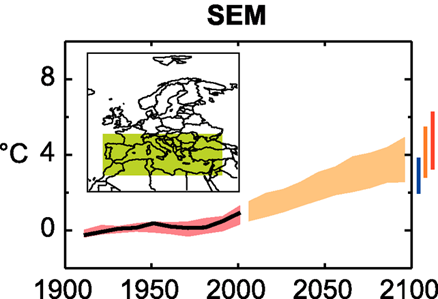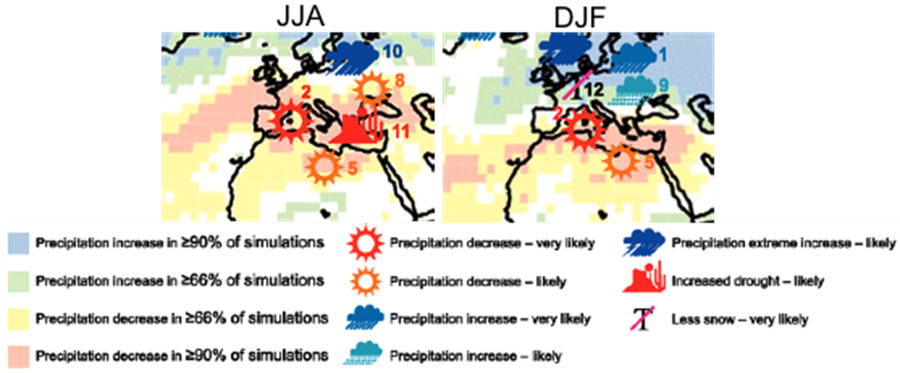TUNESS Chart of the Week (TCW), Monday April 15, 2013
Continuous scientific efforts to identify the mechanisms responsible for the recent observed variations of the Earth's climate have led to further evidence that "most of the observed increase in global average temperatures since the mid-20th century is very likely due to the observed increase in anthropogenic greenhouse gas concentrations" (IPCC 2007).
In this note, we briefly describe how projected climate changes might affect the region encompassing Tunisia, using results from the fourth Assessment Report (AR4) of the United Nations Intergovernmental Panel on Climate Change (IPCC) published in 2007. The Fifth Assessment Report (AR5), which is now underway, is expected to be finalized in 2014.
Regional projections of temperature changes over the Southern Europe Mediterranean (SEM) area indicate that temperatures have increased since the beginning of the 20th century and that the whole SEM region is very likely to keep warming during this century (Fig.1). Under the A1B scenario, the simulated annual mean warming from the 1980-1999 period to 2080-2099 period varies from 2.2°C to 5.1°C with greater values under other climate change scenarios. The different scenarios describe different narrative storylines that represent different demographic, social, economic, technological, and environmental developments yielding with different climate forcings. The A1B scenario describes a future world of very rapid economic growth, global population that peaks in mid-century and declines thereafter. The B1 scenario puts more emphasis on sustainable development while the A2 scenario is more regionally-oriented.

Fig1 (from IPCC AR4 WG1): Temperature anomalies with respect to the 1901 to 1950 average for the Southern Europe Mediterranean (SEM) region for 1906 to 2005 (black line) and as simulated (red envelope) by a range of multi-models incorporating known forcings; and as projected for 2001 to 2100 by the multi-models for the A1B scenario (orange envelope). The bars at the end of the orange envelope represent the range of projected changes for 2091 to 2100 for the B1 scenario (blue), the A1B scenario (orange) and the A2 scenario (red).
The highest summer temperatures over the Mediterranean region are likely to increase more than average summer temperatures. Seasonal and annual precipitation is also projected to decrease by the end of the century in most of the Mediterranean area and northern Sahara, meaning that the warmer conditions will be accompanied by drier conditions, increasing the risk of summer droughts (Fig 2). Desert dune shifts are also likely to occur in northern Sahara. These climate variations have the potential to impose additional pressures on water availability (IPCC AR4 WG2). Model projections indicate that more people in North Africa could experience water stress by 2055. Climate change should thus be considered among a broad range of other water governance issues in future access to water, in particular in rural areas. While one needs to keep in mind the limitations and uncertainties inherent to all regional model projections and not over-interpret the results, this regional assessment is based upon state-of-the-art climate model experiments, regional climate models, statistical downscaling and process understanding, that increase the robustness of the findings.
Fig 2 (from IPCC AR4 WG1):Robust findings on regional climate change for mean and extreme precipitation, drought, and snow.
Study prepared by Rym Msadek, PhD, TUNESS Research Team
References:
IPCC AR4 WG1, 2007: The Physical Science Basis. Contribution of Working Group I to the Fourth Assessment Report of the Intergovernmental Panel on Climate Change by Solomon, S., D. Qin, M. Manning, Z. Chen, M. Marquis, K.B. Averyt, M. Tignor and H.L. Miller (eds.). Cambridge University Press, Cambridge, United Kingdom and New York, NY, USA. [Regional Climate Projections by Christensen, J.H., B. Hewitson, A. Busuioc, A. Chen, X. Gao, I. Held, R. Jones, R.K. Kolli, W.-T. Kwon, R. Laprise, V. Magaña Rueda, L. Mearns, C.G. Menéndez, J. Räisänen, A. Rinke, A. Sarr and P. Whetton]
IPCC AR4 WG 2, 2007: Impacts, Adaptation and Vulnerability. Contribution of Working Group II to the Fourth Assessment Report of the Intergovernmental Panel on Climate Change, by M.L. Parry, O.F. Canziani, J.P. Palutikof, P.J. van der Linden and C.E. Hanson, Eds., Cambridge University Press, Cambridge UK, 433-467. [Africa by Boko, M., I. Niang, A. Nyong, C. Vogel, A. Githeko, M. Medany, B. Osman-Elasha, R. Tabo and P. Yanda]

